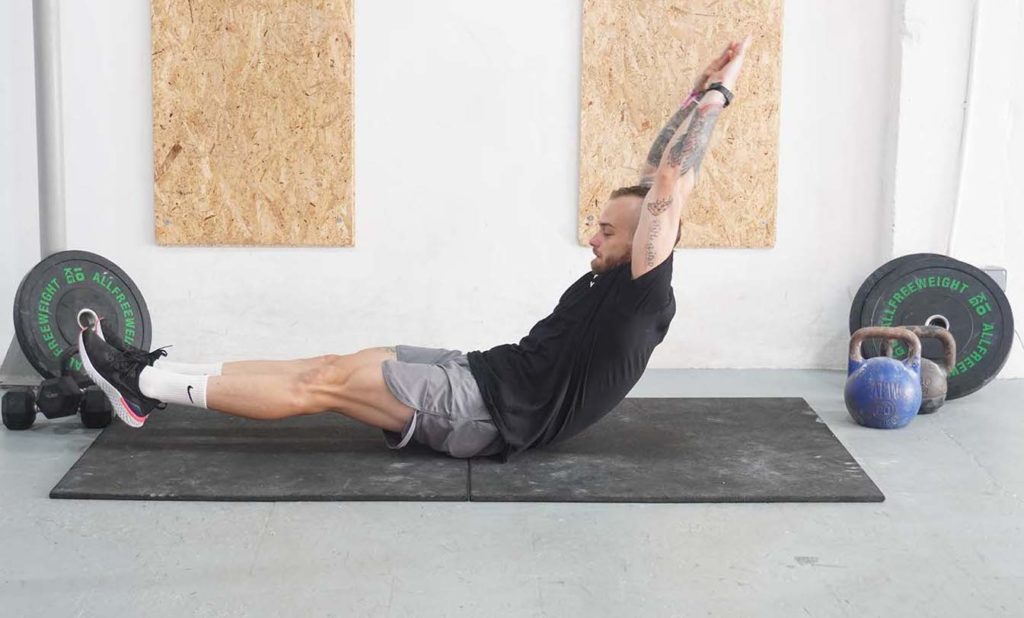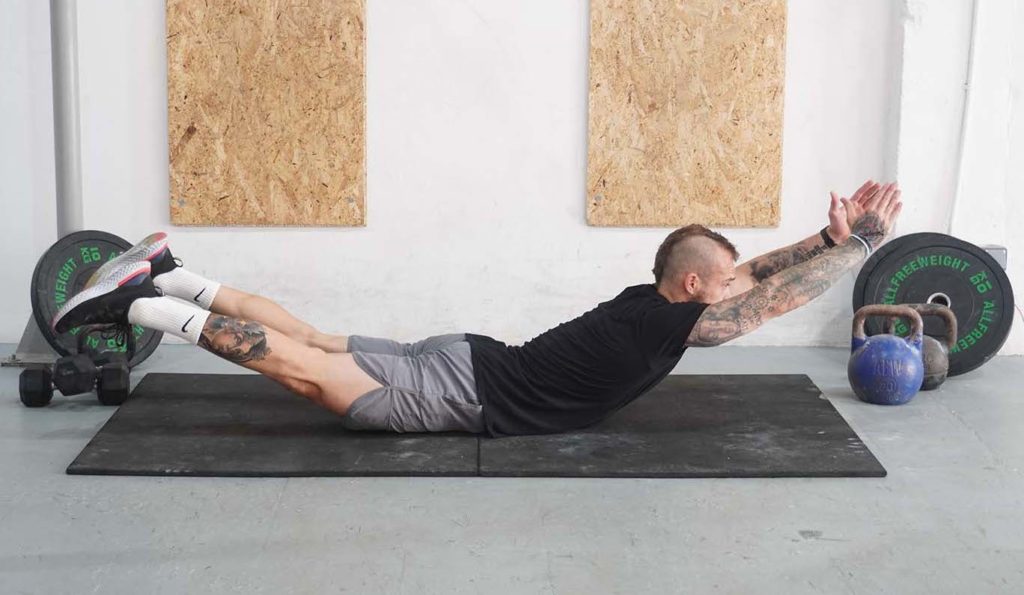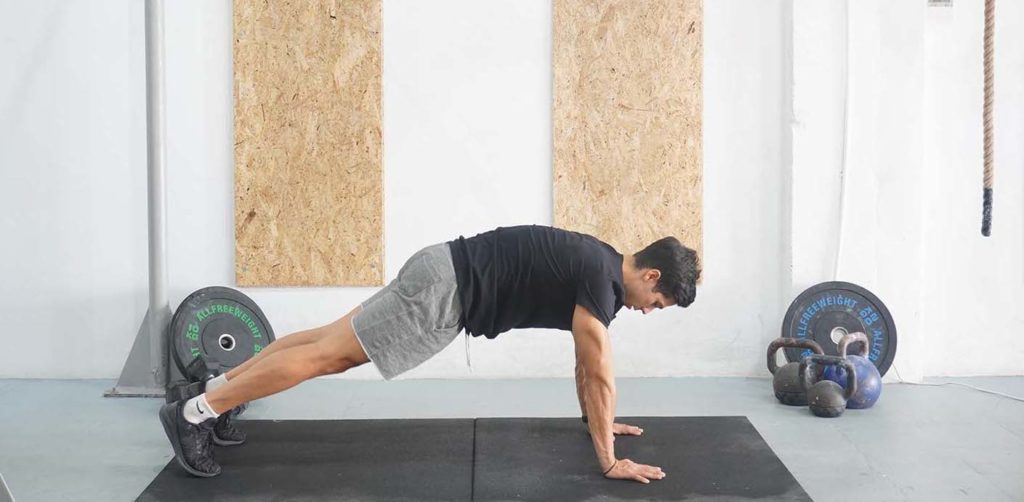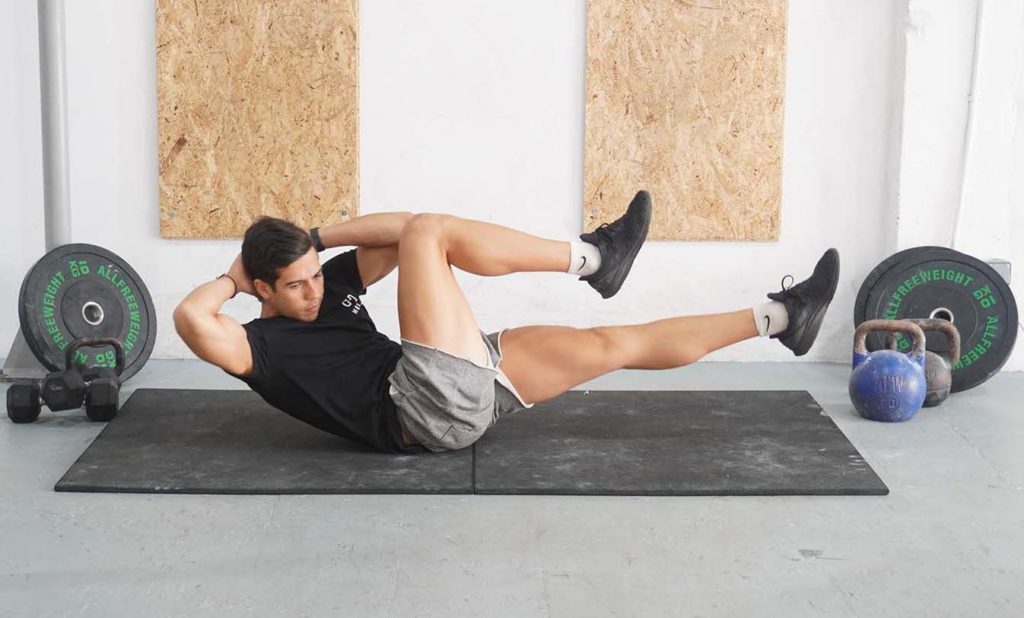Why is a hollow rock hold a beneficial exercise?
Your abs, obliques, and the remaining core muscles work hard each time you lift a weight, carry or throw something, or simply walk down the street.
Hollow rocks are simple to understand and do. But as you lie down to do this exercise, you quickly realize there is more to it than meets the eye. Hollow rocks are challenging and force you to maintain a neutral spine as you hold the position. As a direct benefit, hollow holds build a rock-solid core, elevate your performance on many strength exercises, and allow you to keep your spine in a healthy position.
How to do a Hollow Rock Hold
- Lie down on an exercise mat. Have your hands to your sides, feet together, and legs straight.
- Get a feel for the movement by contracting your abs as if you’re trying to initiate a crunch. Doing so will put your lower back against the exercise mat.
- Squeeze your thigh muscles as your legs are together and lift your feet a couple of inches off the floor. Keep your legs straight.
- Lift your head a couple of inches off the floor and simultaneously extend your arms back behind your head and slightly up. Your lower back should contact the floor during the setup and as you hold in position afterward.
- Hold the position for as long as you can and breathe regularly. Aim for 20 to 30 seconds initially, and slowly work up to minute-long holds.
- Optional: As you hold this position, begin to rock back and forth gently. Your legs can elevate more as your upper back gets in contact with the floor and vice-versa.
What muscles do hollow hold work?
The primary muscles that work during hollow rocks are your rectus and transverse abdominis. Your rectus abdominis is a superficial muscle that controls the area between your ribcage and pelvis (1). Contracting the muscle shortens the distance between the two and provides stability. The transverse abdominis is a deep muscle that envelops your stomach area like a belt. Its primary functions are to stabilize the spine and pelvis (2).

Hollow holds also train your obliques – the muscles on either side of your rectus abdominis. The internal and external obliques function to draw your chest in, provide intra-abdominal pressure, rotate your torso, and resist rotational forces (3, 4).
Hollow rocks also train your hip flexors and rectus femoris, which support the hip angle you maintain during the activity. Finally, hollow holds train your back – rhomboids, trapezius, and erector spinae. Similar to the other muscle groups, these contract isometrically to support your position.
Tips on Proper Technique for the Hollow Hold
1. Press Your Lower Back Into The Floor
You’re probably aware that many gym exercises require a slight arch in the lower back to pull off effectively. Two examples here are the bench press and reverse hyperextension. The hollow rock is different because you have to do the opposite: round your lower back and press it against the floor. Doing so will engage your abs better, allow you to stay in position, and train the correct muscles.
2. Keep Breathing
To maintain their position, people often forget to breathe regularly, making the exercise unnecessarily complex. As you hold a position, breathe periodically and as deeply as you can with engaged abs.
3. Progress to Hollow Holds Gradually
The hollow hold is a fantastic exercise, but not everyone can pull it off immediately. If you find that you can’t hold the position for longer than two to three seconds, progress gradually. For instance, start by only raising your feet a few inches off the floor and holding them that way. Then, only raise your upper back off the floor and keep your legs on the floor. Once you’ve built some core strength, try raising your upper back and feet off the floor simultaneously.
Variations and Modifications of the Hollow Rock Hold
1. Hollow Rock

The most common variation of the hollow hold is the hollow rock. You still have to maintain the hollow hold position, but you now get to rock back and forth. As your legs move away from the floor, your upper back gets closer to it, and vice-versa.
2. Weighted Hollow Hold
The hollow hold offers an excellent overloading potential. Grab a pair of dumbbells, get into the hollow hold position and raise them over your torso. The extra weight will force your core muscles to work extra hard to keep your upper back off the floor.
3. Hollow Hold With Bent Knees
If you can’t quite do a hollow hold with straight legs, do so with your knees bent. Doing so reduces the tension on your abs and allows you to maintain your position with less effort.
Mistakes to Avoid
The first and most common mistake to avoid with hollow holds is arching your lower back. We often try to maintain an arch in the lower back while learning new exercises, so it becomes a habit. But remember that hollow holds encourage slight lower back roundness for superior abdominal activation.
Another mistake to watch out for (if you decide to rock) is not controlling the movement as you do so. The hollow rock is a fun exercise, but you need to control the back and forth movement. Raise one side of your body a few inches and lower the opposite one proportionally. Avoid losing position or moving your body up and down too much.
The final mistake worth mentioning here is keeping your shoulder blades on the floor. The goal is to raise your upper back off the floor, which will engage your rectus abdominis (particularly the upper portion). Raising only your head off the floor is more comfortable but makes the movement less effective.
Similar Exercises to the Hollow Rock Hold
Superman Hold

Aside from the impressive name, the Superman hold is also effective and similar to hollow holds. Both are isometric movements – meaning you have to maintain a position for some time. The primary difference is that hollow holds have you lie on your back, whereas Superman holds on your stomach. Both movements train your core and upper back.
Plank

Planks are another effective and challenging isometric movement with many similarities to the hollow hold. Like hollow holds, the plank also works your entire core and promotes stability, translating to better performance in the gym. In both cases, you assume a position and hold it for as long as possible, making sure to engage your abdominal muscles for optimal results.
Bicycle Crunch

Bicycle crunches are among the oldest and most popular ab exercises. The movement might also be more similar to hollow holds than most people imagine. You lie on your back for both activities, and you have to raise your upper body and feet off the floor. That alone forces your core to work hard, but bicycle crunches take it a step further by including alternating upper and lower body movements.

